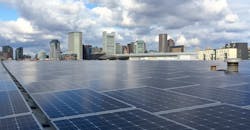Shining Cities report: 10X increase in Solar in 15 major U.S. Metros since 2014
The life of the land in Honolulu is perpetuated more and more by solar energy, according to a new report.
The Hawaiian city and also Las Vegas topped a new report focused on the amount of solar capacity per capita. The eighth edition of the Shining Cities 2022: The Top U.S. Cities for Solar Energy report has been released by the Environment America Research & Policy Center and Frontier Group. (See image gallery for images detailing the report)
This survey of 56 cities tracked the installed solar PV capacity through December 2021. The cities with 100 or more watts of solar PV installed per resident were labelled as “Solar Superstars” and those with over 50 watts per person were ranked “Solar Stars.”
As per the data, a tenfold increase in solar capacity was observed in 15 cities between 2014 and 2022. The number of Solar Stars in the U.S. have increased from just eight in 2014 to 34 now. The U.S. has 121.4 GW of solar PV capacity installed, which is sufficient to power over 23 million homes.
The top cities for solar per capita are:
1. Honolulu, HI
2. Las Vegas, NV
3. San Diego, CA
4. Albuquerque, NM
5. San Jose, CA
6. San Antonio, TX
7. Burlington, VT
8. New Orleans, LA
9. Phoenix, AZ
10. Washington, DC
Honolulu had 1,133.5 Watt per capita solar and a total solar capacity of 397.8 MW. San Diego had 337.4 Watt per capita solar and a total solar capacity of 468 MW.
The top cities for total solar
1. Los Angeles, CA
2. San Diego, CA
3. Las Vegas, NV
4. Honolulu, HI
5. San Antonio, TX
6. New York, NY
7. Phoenix, AZ
8. San Jose, CA
9. Albuquerque, NM
10. Washington, DC
Los Angeles, which tops the total solar rank list has total solar capacity of 649.9 MW and 166.7 Watts per capita solar. It ranks 14th in per capita rank.
By region, the leading solar cities are Honululu in the Pacific region, Las Vegas in the Mountain region, Indianapolis in the North Central region, San Antonio in the South Central region, Washington D.C. in the South Atlantic region and Burlington in the Northeast region.
The growth in PV installations is the result of favorable policies devised by governments. However, the report noted that many states have considered a rollback to net metering and some states and utilities have set special charges, fees and rate designs for solar customers, making solar panel installations unattractive. These changes can stall the development of solar resources.
“Local leaders have a key role to play when it comes to helping communities reap the benefits of solar power,” said Adrian Pforzheimer, lead report author and policy analyst at Frontier Group. “Some of the most effective tools in their toolbox for helping solar thrive include committing to 100% renewable energy, using a streamlined online permitting process, and providing rooftop solar owners with fair compensation for the clean electricity that they share with their neighbors.”
About the Author
EnergyTech Staff
Rod Walton is senior editor for EnergyTech.com. He has spent 17 years covering the energy industry as a newspaper and trade journalist.
Walton formerly was energy writer and business editor at the Tulsa World. Later, he spent six years covering the electricity power sector for Pennwell and Clarion Events. He joined Endeavor and EnergyTech in November 2021.
He can be reached at [email protected].
EnergyTech is focused on the mission critical and large-scale energy users and their sustainability and resiliency goals. These include the commercial and industrial sectors, as well as the military, universities, data centers and microgrids.
Many large-scale energy users such as Fortune 500 companies, and mission-critical users such as military bases, universities, healthcare facilities, public safety and data centers, shifting their energy priorities to reach net-zero carbon goals within the coming decades. These include plans for renewable energy power purchase agreements, but also on-site resiliency projects such as microgrids, combined heat and power, rooftop solar, energy storage, digitalization and building efficiency upgrades.
